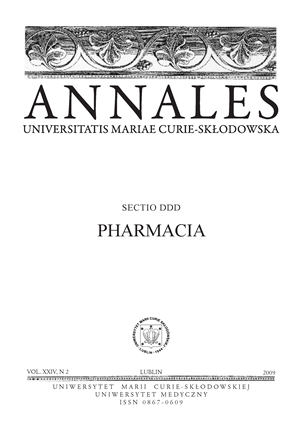Multivariate analysis of UV spectra of complex herbal mixturesand essential oils
DOI:
https://doi.org/10.2478/v10080-008-0181-zAbstract
44 UV spectra of essential oils and plant extracts were analyzed in multivariate way by robust principal component analysis. Although the samples were not clustered against their chemical composition, an interesting dependence was found. Most of the oils had the first PC1 positive, other samples – negative, which was connected with an intensive band just above 200 nm and above 300 nm. These results suggest the ability to distinguish between oils and other extracts by discriminant analysis models, and first PC1 acts as a good discriminant.
References
1. Barnes R. J., Dhanoa M. S., Lister S. J.: Standard Normal Variate transformation and de-trending of near-infrared diffuse reflectance spectra, Appl. Spectr., 43, 772, 1989.
2. Croux C., Ruiz-Gaze n A.: High Breakdown Estimators for Principal Components: the Projection-Pursuit Approach Revisited’, J. Multivariate Anal., 95, 206, 2005.
3. Croux C., Filzmoser P., Oliveira M.: Algorithms for Projection-Pursuit Robust Principal Component Analysis, Chemom. Intell. Lab. Syst., 87, 218, 2007.
4. Daszykowski M., Walczak B., MassartD. L.: Projection methods in chemistry, Chemom. and Intell. Lab. Syst., 65, 97, 2003.
5. Komsta Ł., Skibiński R., Gałaszkiewicz A., Grech-Baran M.: Mapping of the UV spectra of drugs by principal and independent component analysis (PCA and ICA), Annales UMCS. sect. DDD, 20, 115, 2007.
6. Luthria D. L., Mukhopadhyay S., Robbins R. J. et al.: UV Spectral Fingerprinting and Analysis of Variance – Principal Component Analysis: a Useful Tool for Characterizing Sources of Variance in Plant Materials. J. Agricult. Food Chem., 56, 5457, 2008.
7. Mark H., Workman J.: Chemometrics in Spectroscopy, Academic Press, 2007.
Downloads
Published
Issue
Section
License
Copyright (c) 2025 Aleksandra Bojarczuk, Robert Skibiński, Łukasz Komsta (Autor)

This work is licensed under a Creative Commons Attribution-NonCommercial-NoDerivatives 3.0 Unported License.


